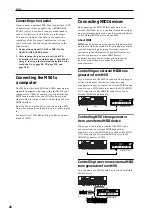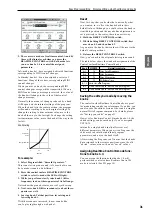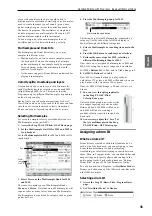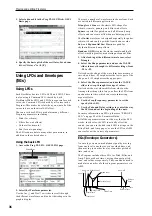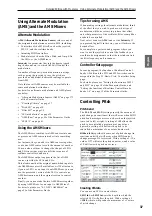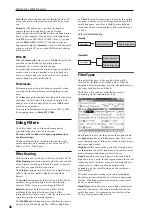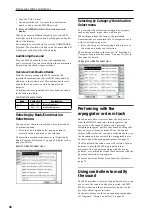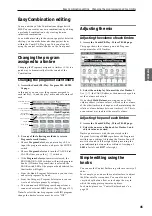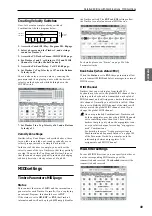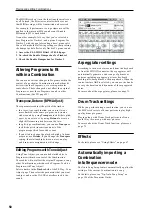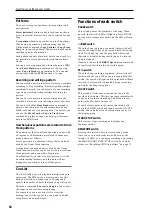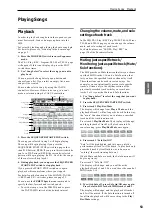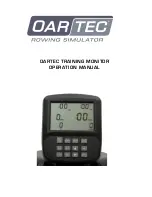
Playing and editing Programs
38
JS+Y Int
specifies the amount of vibrato that the LFO
will produce when the joystick is pushed away from
you.
Intensity
(AMS Intensity) specifies the depth of
vibrato that will be applied by the LFO when
modulated by the selected AMS (Alternate Modulation
Source). For example, if the panel switch assignment
for SW1 is set to SW1 Mod. (CC#80) (Prog 1–7a), and
you set LFO1 AMS to SW1: CC#80 and specify an
appropriate value for Intensity, vibrato will be applied
when you turn SW1 on or when MIDI control change
#80 is received.
Pitch EG
When the Intensity value is set to +12.00, the pitch EG
specified in the Pitch EG page will produce a
maximum of ±1 octave of pitch change.
To realistically simulate the slight change in pitch that
occurs when a string is plucked or at the attack of a
brass or vocal sound, you can use the EG to create a
subtle change in pitch at the attack.
Portamento
Portamento makes the pitch change smoothly when
you play the next note before releasing the previous
note.
The Time parameter controls how long it take the pitch
to change. As this value is increased, the pitch will
change over a longer time. With a value of 000, there
will be no portamento.
You can turn Portamento on and off via SW1 or SW2,
by assigning them to Porta.SW CC#65.
Using Filters
The filters allow you to diminish or emphasize
specified frequency areas of the sound.
The tone of the sound will depend significantly on
the filter settings.
The basic filter settings, including the routing, type,
cutoff frequency, and resonance, are set on the P3–1:
Filter1 or P3–2: Filter2 page.
Filter Routing
Each oscillator has two filters, Filter A and Filter B. The
Filter Routing
parameter controls whether one or both
of the filters are used, and if both are used, it controls
how they are connected to each other.
The Single routing uses only Filter A as a single 2-pole,
12dB/octave filter (6dB for Band Pass and Band
Reject).
The Serial routing uses both Filter A and Filter B. The
oscillator first goes through Filter A, and then the
output of Filter A is processed through Filter B.
Parallel
also uses both Filter A and Filter B. The
oscillator feeds both filters directly (and allow
independent settings for each), and the outputs of the
two filters are then summed together.
The 24dB(4Pole) routing merges both filters to create a
single 4-pole, 24dB/octave filter (12dB for Band Pass
and Band Reject). In comparison to Single, this option
produces a sharper roll-off of frequencies beyond the
cutoff frequency, as well as a slightly more delicate
resonance. Many classic analog synths used this type
of filter.
Serial and Parallel Routing
Filter Types
This selects the parts of the sound which will be
affected by the filter, as described below. With the
Serial and Parallel routings, you can independently set
the types for Filter A and Filter B.
The filters will produce very different results
depending on the selected filter type.
Low Pass:
This cuts out the parts of the sound which
are higher than the cutoff frequency. Low Pass is the
most common type of filter, and is used to make bright
timbres sound darker.
High Pass:
This cuts out the parts of the sound which
are lower than the cutoff frequency. You can use this to
make timbres sound thinner or more buzzy.
Band Pass:
This cuts out all parts of the sound, both
highs and lows, except for the region around the cutoff
frequency. Since this filter cuts out both high and low
frequencies, its effect can change dramatically
depending on the cutoff setting and the oscillator’s
multisample.
With low resonance settings, you can use the Band
Pass filter to create telephone or vintage phonograph
sounds. With higher resonance settings, it can create
buzzy or nasal timbres.
Band Reject:
This filter type–also called a notch filter–
cuts only the parts of the sound directly around the
cutoff frequency. Try modulating the cutoff with an
LFO to create phaser-like effects.
Filter A (Low Pass)
Oscillator
Oscillator
Filter B (High Pass)
Filter A (Low Pass)
Filter B (High Pass)
Содержание EASYSTART M50
Страница 1: ...3 E Owner s Manual ...
Страница 84: ...Arpeggiator function 78 ...
Страница 88: ...Drum Track function 82 ...
Страница 92: ...Settings for the entire M50 86 ...



